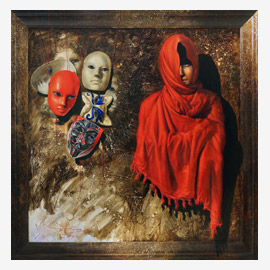A conjoined aura of hallucinogenic and metaphysical realms appears to reverberate through much of Vijender Sharma’s vast and varied art-scape. In a free play of mystery and surrealism his paintings feature an expanse, that is bold and beautiful, sensuous and pristine, real and imagined, love and hate, life and death, greed and hypocrisy, joy and pain, dreams and nightmares, masks and clowns, or ideas and idealism. The repository it seems is essentially about people, life and human nature. “I...
A conjoined aura of hallucinogenic and metaphysical realms appears to reverberate through much of Vijender Sharma’s vast and varied art-scape. In a free play of mystery and surrealism his paintings feature an expanse, that is bold and beautiful, sensuous and pristine, real and imagined, love and hate, life and death, greed and hypocrisy, joy and pain, dreams and nightmares, masks and clowns, or ideas and idealism. The repository it seems is essentially about people, life and human nature. “I get lost when I am painting”, claims the artist for whom reality and duality of life are integral to his creative genre.
The early track the artist has had to traverse through has been somewhat rough and patchy. Son of a policeman and born in Delhi as one of the four siblings, Vijender grew up in a middle-class humble family that lived in the city having migrated from Uttar Pradesh. During his schooling, the young boy enjoyed doodling and drawing though also followed his studies regularly. A dreamer, he often toyed in his mind as to which of the three career paths that he had shortlisted - to join the army, turn an ascetic or be a painter - should he take up, once he grows up. Mercifully the divine sorted this out for him. His weak eyesight blocked his entry into the first profession and compulsions to earn a living ruled the second one out, taking him onto a course by engaging him in his inborn passion and talent for art.
Like many of his contemporaries, he too has had to struggle during the early phase of his career. With very few galleries and hardly any collectors around, he had to survive by taking up small time commissioned assignments. He made portraits, designed book covers, did illustrations, made cartoons, cinema hoardings and posters. The fees he received for these assignments helped him pull through a difficult phase. Given his deft hand and fine technique, soon some prestigious commissions came his way. He did design work and made paintings for popular TV serials – B.R. Chopra’s ‘Mahabharata’ and Ramanand Sagar’s ‘Ramayana’ amongst others. This brought him fame name and much needed financial security besides bringing his work to the attention of the gallery and collector sectors. Several successful and sell-out shows followed in quick succession, winning him critical acclaim too.
Read more

































